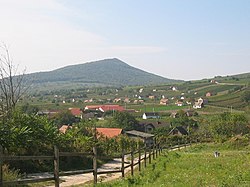Villány Mountains

The Villány Mountains [ ˈvilːaːɲ ] (Hungarian: Villányi-hegység ) is an elongated, isolated mountain range in the extreme south of Hungary , which stretches from west to east .
It reaches heights of up to 442 m, but rises an average of 300 m above the flat surroundings ( Pannonian Plain ), which is only 100 m above sea level on the Drava , which flows 5 km south and comes from Austria and Slovenia . The two highest peaks are the Tenkes with 408 m and the Szársomlyó with 442 m. The mountain range is very dry, there are no watercourses and only a few springs that arise on the slopes running south. The best known are the sulfur spring of the Harkány thermal bath and the Tapolcza spring in front of the Siklós castle . A rich spring is located below the monastery in the pilgrimage site of Máriagyűd (formerly Gyüd ), which is located northeast of Harkány on the slope of the small mountain range.
The hilly landscape made up of Mesozoic limestone and dolomite layers is known not only for its cultural characteristics but also for its viticulture on the seven hills . It is named after the place Villány (German "Willand") on the eastern edge of the 15 km long mountain range, the largest settlement - directly on the southern slope of the middle section of the ridge - is the town of Siklós . The ridge begins in the west between the villages of Siklósbodony (formerly Bodony ) and Diósviszló . At Csarnóta , the Hungarian main road 58 crosses the mountain range from the north and reaches Harkány in the south. The rocky elevations resemble a row of tents. In the east, near the wine-growing village of Nagyharsány , the Harsány hilltop (Szársomlyó) rises up with its barely overgrown steep slopes. In 1968 the sculptor symposium Villány took place in a former quarry on its eastern slope , where sculptures from repeated events are exhibited (Szoborpark Nagyharsány).
The Villány Mountains are part of the southern part of Baranya County or the Southern Transdanubia region . There are some old castles ( Vár ) and defenses from the times of the Turkish wars here .
The regional capital Siklós is a town with 10,900 inhabitants and the economic, cultural and administrative center of the small area Siklós . It is located 31 km south of the city of Pécs . Siklós and numerous places and small towns in the region - especially near Villány - are historical settlement areas of the Danube Swabians and - with some interruption after the end of the Austro-Hungarian monarchy - again have bilingual place-name signs, some also trilingual (also Croatian or Serbian ).
Viticulture in the region
The Danube Swabians (better to be called Hungarian Germans ) were settled in the region after the Turkish Wars under Empress Maria Theresa and, after the victories of the Habsburgs and Croats over the Ottomans, brought not only an economic upturn to the depopulated southern and eastern regions of the Kingdom of Hungary , but also some new grape varieties from their ancestral home to Pannonia with (e.g. the Portuguese ). They are processed into two red wines typical of the region .
The wine from Villány and the surrounding area has also gained a good reputation outside of Hungary. There are countless wine cellars on the Villány-Siklós wine route.
Web links
- Homepage of the city of Villány (Hungarian)
Individual evidence
- ↑ a b Alexander Baksay: The Baranya Comitat . In: The Austro-Hungarian Monarchy in words and pictures . Hungary . Volume 4. Vienna 1896, p. 327
Coordinates: 45 ° 53 ' N , 18 ° 21' E

